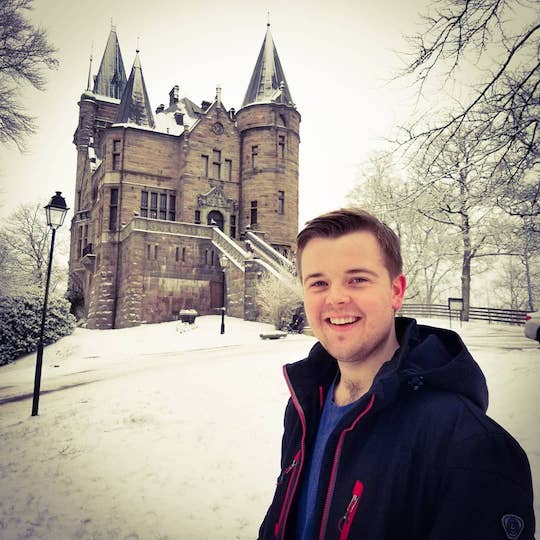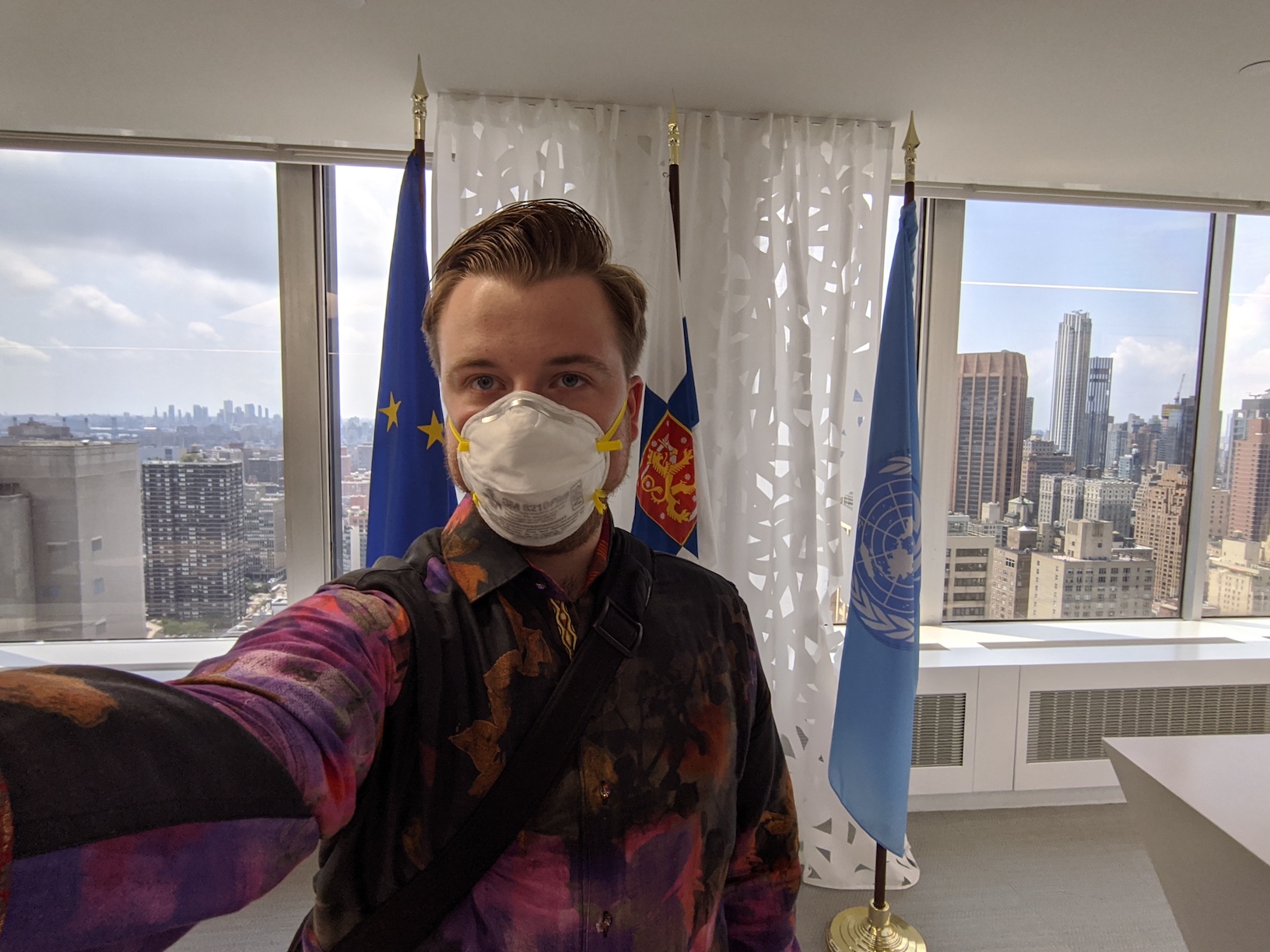My name is Alex Beattie and over the past four years I have lived in three countries and have navigated the challenges of working and traveling during a global pandemic.
Semester in Sweden
 |
 |
|---|---|
| The Linneaus University Campus Castle | Seeing the Northern Lights for the first time |
On a cold winter day in early 2019, I traveled from St. Louis, Missouri to Växjö, Sweden to commence a semester study abroad program at Linneaus University. Returning to the U.S. that summer with a fresh mindset, I began to wonder if it was possible to continue my development in a global context. In Sweden, I brushed off emails from my university’s fellowship office encouraging me to apply for national grants and fellowships.
Return to Missouri
Back in the United States during my summer internship, the thought of those fellowships lingered in the back of my mind. I decided to pursue it and contacted the M.U. Fellowship Office about their global fellowship opportunities. After an extensive discussion of the programs, the U.S. Fulbright Student Program stood out, as it “provides grants for individually designed study/research projects or for English Teaching Assistant Programs.”
Completing my summer internship in July 2019, my senior year of undergrad was about to begin. My advisor encouraged me to narrow down which country and degree program I wanted to apply for and begin writing. I completed the first draft of essays that summer before the full rigor of senior year began. During the Fall semester, after more than 80 hours of work and 10 revisions, my Fulbright application was complete.
Submitting the Fulbright Application
My interview with the campus review board was scheduled for mid-September. I sat outside the conference room and thought about the rewards if my hard work paid off. The interview gave me insight into how I could further focus my application and make it outstanding in the face of the incredibly competitive applicant pool. After a few more revisions, I ensured all my references would be ready to submit by the early October deadline.
I logged on to the Fulbright portal, a week early per my advisor’s recommendation, and began uploading the documents and prepared statements. I saw that the recommendation letters were submitted, and I hit submit. Pressing that button, I felt a sense of relief coupled with anxious anticipation. The waiting game had begun.
The Fulbright timeline was quite vague and mentioned I would receive a notification of semi-finalist status between December and February. In mid-December, my notification came early with a suspenseful portent:
Dear Alexander Beattie,
Thank you for applying to the 2020–21 Fulbright U.S. Student Program.
Please log into the Fulbright Online Application System to view your status.
Subsequent emails from Fulbright would take the same form as this, but this was the first and I apprehensively logged into the application portal. I read the opening words of the letter:
Congratulations…
I had become a Fulbright semi-finalist! I was overjoyed and began to share the news with my friends and family.
COVID-19 Strikes
In late February, the Marching Mizzou spring break band trip to Ireland was canceled. Mizzou also moved classes completely online and canceled in-person events. In the following weeks we adapted to what would become the new, remote normal. I was nervously hopeful the Fulbright Program would proceed that year.
I read stories of grant recipients returning to the United States from where they were studying with little notice. I thought if I was selected, the program may be canceled or severely delayed. Throughout March, I woke up checking my email thinking that it would be the day, since many other applicants had already received their notifications. March went and April came as I waited. On the afternoon of Thursday, April 9th, 2020, I checked slack and discovered that Finland applications had been notified of their status. With my heart beating, I logged into the portal. Opening the letter I read:
On behalf of the J. William Fulbright Foreign Scholarship Board, I am pleased to congratulate you on your selection for a Fulbright award to Finland.
Still in shock, I printed out the letter and showed my family. They were very proud of my achievement. In my excitement, I was hesitant to tell people though since everything was so uncertain. During the first wave of the pandemic with many areas in lock down, travel bans in full effect, and borders closing, I did not think I would be able to go.
Unprecedented Challenges
I connected with the other grantees going to Lappeenranta, and we met virtually to plan logistics. The Fulbright Finland Commission and prior grantees completing their second year of the master’s degree were incredibly helpful in the process. Even with their help, as new grantees during a global pandemic we were in uncharted territory.
Fulbright had been delayed until January with a few caveats. Fulbright degree students could begin their studies in the Fall if they could secure the appropriate permits and the Department of State Travel advisory was reduced from Level 4 ( since Fulbright is a State Department program). With this glimmer of hope we began trying to start the complex process for traveling to Finland for 2 years.
At the time, all the Consulates and Residence Permit Processing Centers were closed. It is impossible to obtain a residence permit for Finland without having biometrics done at one of these places. Without a residence permit it would be impossible to travel to Finland. I began preparing to begin my studies online. Then in late June, the Finnish government announced that the Consulates would begin taking biometrics appointments for residence permits for students studying in Finland in a limited capacity. I emailed the consulate in New York and was able to get an appointment in July. Normally I would visit the permit processing office in Chicago and plan the trip in advance.
Consular Appointment in New York
I had a week to prepare to fly to New York from St. Louis during the beginning of the unknowns that would shape the long course of the pandemic. On July 7, 2020, I boarded a Southwest airlines flight to New York LaGuardia for my first visit to the Big Apple. An eerily quiet silence filled the terminal as I walked through the arrivals area to the pickup zone. I climbed into a Lyft bound for the hostel I was staying at and checked in. A strange calm permeated the normally bustling city. As I walked through the streets and ate outside on local terraces, it felt deserted.
When it came time for my appointment the next day I arrived 15 minutes early. The check-in attendant for the building did not have my name on the list and would not let me in. He told me to call the consulate office to resolve the matter, but the phone line kept ringing. After many attempts, I was able to reach the Consulate receptionist who properly entered me into the building reservation system. After a few inconsistent scans with the body temperature machine, I met an employee of the Finnish Consulate. He was coming into work for the day and escorted me up to the office. During my half-hour appointment, the consulate service member took my fingerprints and reviewed my documents. In less than an hour, I was filled with relief on my way down the elevator with my biometric identification complete.
 Visiting the New York Finnish Consulate
Visiting the New York Finnish Consulate
I had traveled nearly a thousand miles for this appointment and as I left it did not feel real. Something that I had thought about and planned so much for was finally complete. While still in New York, I visited my uncle and spent a few afternoons and evenings with him. He told me that in all the years he had lived there he had never seen the city so empty and so quiet. I had not seen him in a few years and it was nice to reconnect after so long. Upon returning home to Missouri I anxiously awaited the permit in the mail.
 The sunset in New York during my visit to the Consulate
The sunset in New York during my visit to the Consulate
Preparing for Finland
The permit arrived a few weeks later, and I prepared to travel to Finland, paid the first months rent for my apartment, and handled last-minute logistics. The Department of State (DOS) travel advisory was still at Level 4, and I was fearful that even though I had come this far I still would not be allowed to go. I was eating lunch at Mod Pizza in early August with my brother when he looked at his phone and said the DOS dropped the global travel advisory. A little shocked I asked him to repeat. Immediately I went to the website and checked to see that Finland was at a level 3! I had my residence permit and the travel advisory had been reduced! Everything was a go! I had two weeks and began hurried packing and preparations for my first international flight during the pandemic, which I will cover in the next post.